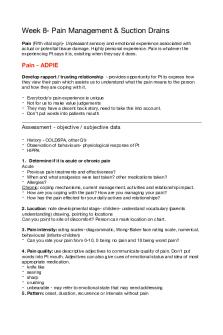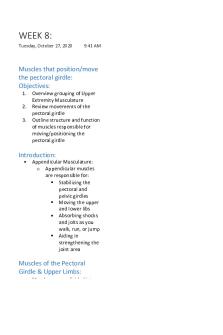Week 8 – social Anthropology Theory – reading notes PDF

| Title | Week 8 – social Anthropology Theory – reading notes |
|---|---|
| Author | Guy Flynn |
| Course | Social Anthropology Theory |
| Institution | Oxford Brookes University |
| Pages | 6 |
| File Size | 100 KB |
| File Type | |
| Total Downloads | 34 |
| Total Views | 134 |
Summary
Bullet pointed summary of the required reading for week 8 of the module....
Description
Week 9 – social Anthropology Theory – reading notes Interpretive and symbolic Anthropology Symbols in Ndembu Ritual – Victor Turner
‘By “ritual” I mean prescribed formal behavior for occasions not given over to technological routine, having reference to beliefs in mystical beings or powers.’ ‘I found that I could not analyze ritual symbols without studying them in a time series in relation to other “events,” for symbols are essentially involved in social process.’
As was layed out in the lecture slide: ‘The relation of symbols to social processes and personal transformations’ In terms of the particulars, seeing particular moments (one dance for example) as part of a wider system of meaning.
Matrilineal society… the principle on which the continuity of Ndembu society depends… Matriliny governs succession to office and inheritance of property, and it vests dominant rights of residence in local units. More than any other principle of social organization it confers order and structure on Ndembu social life.
Some of the meanings of important symbols may themselves be symbols, each with its own system of meanings… Meanings of symbols as symbols themselves with their own meanings … for example: Milk tree as symbol meaning is matrilineal society… Matrilineal society as symbol the wider social organization and inheritance through Matriliny??! – ask Louella/ Constantina
the milk tree stands for the unity and continuity of Ndembu society.
‘’Mudyi is our flag’’ – relative symbolism between cultures
As a child will drink from the breasts of its mother for nutrition, the tribesman drinks from the breasts of tribal custom.
Chief is often referred to as the “mother of his people’’
‘’the mother of huntsmanship (mama dawuyang’a).”
the milk tree represents harmonious, benevolent aspects of domestic and tribal life.
Symbols, as I have said, produce action, and dominant symbols tend to become focuses in interaction.
Different group or category for example family, lineage, young people, old people, men, women etc. become focus of different rituals.
-
For example in ‘Nkang'a’ ritual (the ritual for girls at pubity), the focal point is the unity of Ndembu women.
Contextual analysis of the Nkang'a ritual, shows that the ’Mudyi tree (milk tree) distinguishes women as a social category (from men especially) and indicates their solidarity.
When choosing and sacralising a Mudyi tree… in certain action contexts it (the milk tree) stands for the novice herself …Tree’s immaturity is significant… A girl’s particular tree symbolizes her new social personality as a mature woman.
(on the symbolization of the Nkang'a ritual) and a mother able to produce a generous supply of milk. – symbolization apparent; the female breast milk represented by the tree.
CRITIQUE/ ASSUMPTION - For each girl this is a unique process. She is initiated alone and is the center of public attention and care. From her point of view it is her Nkanga, the most thrilling and self-gratifying phase of her life. – is it fiart o assume that this ritual is the most
thrilling and self-gratifying phase of her life? What about marriage? What if she doesn’t feel ready to become a women? He also notes that there will be trials and hardships for the novice, who must suffer before she is glorified – what about these? She may dislike these.
Milk tree site for opposition between mother of novice girl and other adult women. Mother excluded from dancing ring (Could be separation stage of the 3-part model of rites of passage).
A termination of a part of mother-daughter relationship apparent.
Symbolism of the meal prepared by the novices other… spoon represents the novice herself in her role of married woman, while the food stands both for her reproductive power (lusemu) and her role as cultivator and cook.
In the context of action situation, the milk tree is sometimes described by informants as representing the novice’s own matrilineage.
Symbolism seems flexible in nature… considerable discrepancy exists between the interpretations of the milk tree offered by informants and the behavior exhibited by Ndembu in situations dominated by the milk tree symbolism.
p.25, para. 3, good example of how symbolism appears flexible, especially in principle and practice.
A sign,” he says, "is an analogous or abbreviated expression of a known thing. But a symbol is always the best possible expression of a relatively unknown fact, a fact, however, which is none the less recognized or postulated as existing.”
The Anthropologist’s own etic perspective, interpretation and symbolic meanings are of interest.
Personal ‘structural perspective’(Lupton) has influence on meaning making.
Anthropologist can offer greater perspective than actor because has view of whole system
Properties of ritual symbols:
Condensation Unification of disparate significata… bringing together and grouping phenomena and ideas which appear to be very different. Polarization – sensory pole and ideological pole.
“referential” symbols (refers to known facts) and condensation” deeper emotional arousal by symbolism.
The basic unit of ritual, the dominant symbol
Critique/ assumption: A particularly etic comment to come from a social anthropologist and bizarre modes of dress – could apply Mead analysis of taboo and normative behaviour for different societies.
Dominant symbols as constant and consistent throughout Throughout the total symbolic system, similar to Radcliffe-Brown school of thought.
Dominant symbols as representative of the axiomatic values of the widest Ndembu society.
Instrumental symbols.
Symbols as enigmatic
Psychoanalysts, in treating most indigenous interpretations of symbols as irrelevant
Symbols instigate social action. In a field context they may even be described as “forces,”
Good summary of points: the properties we have described, namely, polarization of meanings, transference of affectual quality, discrepancy between meanings, and condensations of meanings, be come most significant.
Ndembu symbols refer to basic human social existence; for example, hunting, female fertility, male virility, favourable climatic conditions)
Psychic symbols inner-drives
Nadel considers, that what is not verbalized is in fact irrelevant either to the participants or to the anthropologist.
Red is widely symbolic for violence, killing etc. in Ndumbu culture however in Nkula ritual it is symbolic of birth process – very different
Contexts of ritual: action-field context and cultural context
Dominant symbols as representing human life.
‘Levels’ of interpretation...
Similar Free PDFs

Week 8 Reading Response Toxicity
- 4 Pages

8/29 Reading Notes
- 2 Pages

Week 8 - Lecture notes 8
- 6 Pages

Week 8 - Lecture notes 8
- 23 Pages

WEEK 8 - Lecture notes 8
- 10 Pages

Accounting Theory week 4 notes
- 12 Pages

Week 8 Notes
- 4 Pages

Week 8 - Lecture notes
- 3 Pages

THTR103 Week 8 Notes
- 4 Pages
Popular Institutions
- Tinajero National High School - Annex
- Politeknik Caltex Riau
- Yokohama City University
- SGT University
- University of Al-Qadisiyah
- Divine Word College of Vigan
- Techniek College Rotterdam
- Universidade de Santiago
- Universiti Teknologi MARA Cawangan Johor Kampus Pasir Gudang
- Poltekkes Kemenkes Yogyakarta
- Baguio City National High School
- Colegio san marcos
- preparatoria uno
- Centro de Bachillerato Tecnológico Industrial y de Servicios No. 107
- Dalian Maritime University
- Quang Trung Secondary School
- Colegio Tecnológico en Informática
- Corporación Regional de Educación Superior
- Grupo CEDVA
- Dar Al Uloom University
- Centro de Estudios Preuniversitarios de la Universidad Nacional de Ingeniería
- 上智大学
- Aakash International School, Nuna Majara
- San Felipe Neri Catholic School
- Kang Chiao International School - New Taipei City
- Misamis Occidental National High School
- Institución Educativa Escuela Normal Juan Ladrilleros
- Kolehiyo ng Pantukan
- Batanes State College
- Instituto Continental
- Sekolah Menengah Kejuruan Kesehatan Kaltara (Tarakan)
- Colegio de La Inmaculada Concepcion - Cebu






